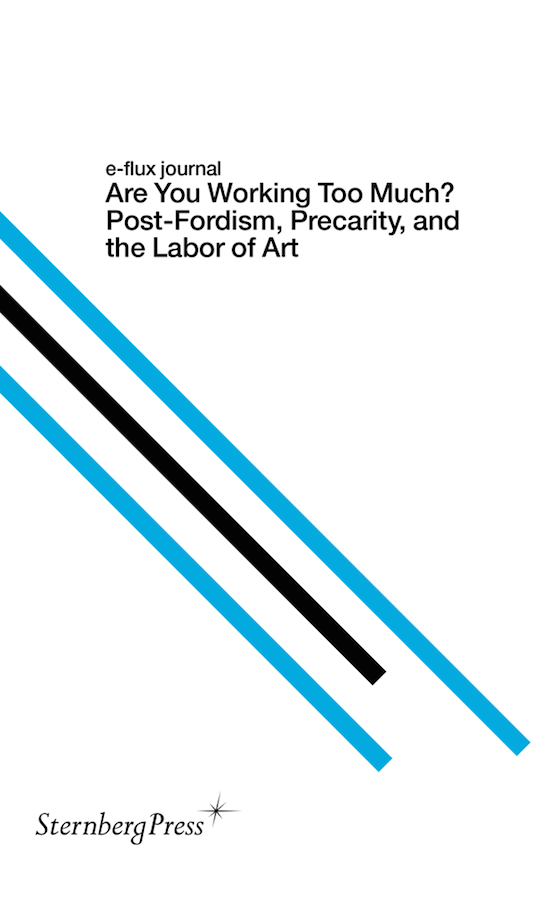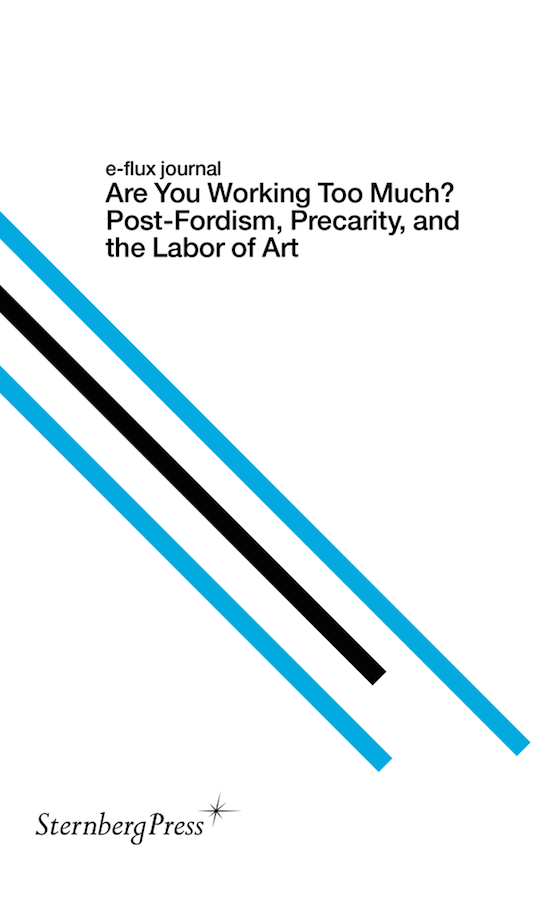Are You Working Too Much? Post-Fordism, Precarity, and the Labor of Art
Let’s be clear about something: it is infuriating that most interesting artists are perfectly capable of functioning in at least two or three professions that are, unlike art, respected by society in terms of compensation and general usefulness. When the flexibility, certainty, and freedom promised by being part of a critical outside are revealed as extensions of recent advances in economic exploitation, does the field of art become the uncritical, complicit inside of something far more interesting?
Edited by Julieta Aranda, Brian Kuan Wood, and Anton Vidokle
Contents:
Julieta Aranda, Anton Vidokle, Brian Kuan Wood, Introduction
Diedrich Diederichsen, “People of Intensity, People of Power: The Nietzsche Economy”
Hito Steyerl, “Politics of Art: Contemporary Art and the Transition to Postdemocracy”
Marion von Osten, “Irene ist Viele! Or What We Call ‘Productive’ Forces”
Liam Gillick, “The Good of Work”
Lars Bang Larsen, “Zombies of Immaterial Labor: The Modern Monster and the Death of Death”
Keti Chukhrov, “Towards the Space of the General: On Labor Beyond Materiality and Immateriality”
Tom Holert, “Hidden Labor and the Delight of Otherness: Design and Post-Capitalist Politics”
Franco “Bifo” Berardi, “Cognitarian Subjectivation”
Antke Engel, “Desire for/within Economic Transformation”
Precarious Workers Brigade, “Fragments Toward an Understanding of a Week that Changed Everything…”
Irit Rogoff, “FREE”
Reviews
“ARE YOU WORKING TOO MUCH?”, KALEIDOSCOPE • Eva Kenny
E-flux’s new book, Are You Working Too Much? Post-Fordism, Precarity, and the Labor of Art, is a collection of texts from their online and print journal that have, over the past year, dealt with the subject of art as work and art-related workers in the post-Fordist economy. Post-Fordism is a term that refers to the conditions of contemporary work as…
E-flux’s new book, Are You Working Too Much? Post-Fordism, Precarity, and the Labor of Art, is a collection of texts from their online and print journal that have, over the past year, dealt with the subject of art as work and art-related workers in the post-Fordist economy.
Post-Fordism is a term that refers to the conditions of contemporary work as it has changed from a factory production line based model. In the latter part of the twentieth century, shifts towards making the workforce more flexible in terms of hours, more specialized in what they do or make as dictated by market demands, and more precarious in terms of rights and benefits as well as an increase in the growth of service industries are generally agreed to be characteristic of Post-Fordist labor conditions. Given that every part of the political, public or civic sphere is now dominated by the economy, it makes sense that the art world be submitted to the same analyses and in fact, the case is made here that art work and art workers are actually paradigmatic of the new conditions of labor. Occupations that previously would not have been considered artistic, like medicine or governance, have learned from art how to be quixotic and virtuosic or, in Diedrich Diderichsen’s expression, “intense.” This develops the argument made by Luc Boltanski and Ève Chiapello in The New Spirit of Capitalism: that capitalism has learned from and incorporated many of the critiques directed at it by avant-garde artists and counter-cultural critiques from the 1960s onwards. In the essays by Diedrich Diderichsen, Mariane Von Osten and Hito Steyerl in particular, there’s a historical look at the changes in the roles played by art and by capitalism in the popular imagination. Diederichsen’s text “People of Intensity, People of Power: The Nietzsche Economy,” describes an advertising company in Dusseldorf in the 1970s that employed an ex-Fluxus artist with “the specific task of interfering with business as usual.” The artist’s brief is to show advertising executives how to be intense and nonconformist: intensity, previously the preserve of artists, is brought into the mainstream to disrupt traditionally managerial thinking and encourage a more creative work environment. When there is a stable Fordist father figure delegating and deciding at the head of the company / firm / state, Diderichsen explains, this system works very well, but Boltanski and Chiapello and the essays in this book diagnose the opposite problem, one of the over-identification of capital, from the top down, with its critics. The question posed by this book, on the back cover, is this: what’s good about art when what used to be good about it (“flexibility, certainty and freedom”) is now what’s bad about the capitalist system?
Something that’s not quite clear, however, is whether it is the art or the still-hanging-in-there mystique around artists that capitalism or this collection of texts is interested in. Hito Steyerl explains: “Post-democratic government is very much related to this erratic type of male-genius-artist behavior. It is opaque, corrupt and completely unaccountable. You see why the contemporary oligarch loves contemporary art: it’s just what works for him.” There has been much discussion lately (e-flux recently published another volume to deal with this question specifically) of the meaning of “contemporary” – a most value-laden term in art discourse. In these texts a major problem seems to be contemporary art’s criticality or lack of criticality vis-à-vis contemporary power structures. The type of art that is popular in the power structures in which we live still has vestiges of an association with rebellion against power structures, commemorated as any other vanquished foe in public spaces. “Contemporary art lends primordial accumulation a whiff of post-conceptual razzmatazz” as Hito Steyerl puts it. But how would contemporary art respond, if there were still an antagonistic relationship between art and capitalism, given that every critique of capitalism is just taken on board by the beast? Why give it ideas? Something that comes across strongly from these texts is the notion that capitalism, whiles very enthusiastic and hardworking, is perhaps not particularly imaginative. Can it think up its own forms of subjugation or does it rely heavily on someone else to do this? A theoretical but nonetheless dramatic standoff is one of the outcomes of this shortcoming: while capitalism in its current incarnation cuts arts funding and starves artists out of their old neighborhoods, watching them fight like gladiators the better to learn even more strategic and cut-throat ways of surviving hard times, art is at the same time pulling the wool over capitalism’s eyes with its ridiculous and inexplicable approaches to absolutely everything. In its returns to the still-unsavory styles of years literally just gone, without a decent rest period in between, or its potluck curated shows or mini-micro-referential streams of nonsense, contemporary art seems to offer little in the way of example for a would-be logic of capitalism. And, in fact and maybe in complete contradiction to this, there are several places in the texts where I felt that the writers were implying that there was actually a cross-over taking place: artists becoming conservative and rising steadily through the ranks as a way of balancing out the cosmic wrongness of entrepreneurial city councilors and competitive health insurances.
In any case, things that contemporary art actually does seem to critique are missed out on by texts in the book. Whereas it seems almost a commonplace now for contemporary artists to use the furnishings and accoutrements of the post-Fordist workplace in office installations, sculptures, powerpoints etc, this volume doesn’t recognize the type of work that happens inside those structures. The introduction talks about “average labor” like “bakers, garbage men, police officers, cobblers, lawyers, engineers, day laborers and so forth” but there is a curious absence in the texts, most of all in Franco “Bifo” Berardi’s account, of another type of cognitive worker, one who falls somewhere between the factory Fordist worker and the contemporary freelancer. Not particularly skilled and not manual laborers, millions of people work only with their brains in call centers, banks, I.T. and other service industries without much libidinal investment in what they do, just waiting to clock out so they can go and live their lives. Only in the most Daniel Day-Lewis-inspired fantasy of the simple life is cobbling a normal job. But why, if artists, and popular culture at large, are using these tropes of conference suites and calls, is there an absence of critical writing about it? Only Diederichsen’s essay touches on the “small, low-risk world where coworkers’ birthdays, other coworkers absenteeism, the irregularities of third parties, and other incalculabilities still matter.” It seems as though any discussion of a precarious, insecure job with none of the perks of an art-related job would undermine the incorporation of art-workers into the same blue-collar dustbowl imaginary rehearsed by artists since at least the 1950s. What these texts concentrate on, it seems to me, is an assembling and would-be-mystifying of a new character in the artworld. Everyone knows about the erratic eccentric artist type. Making a coherent character out of the artist / writer / curator / critic is substantially more difficult and requires the backup of as many tropes of real work as possible; subject-formation around the aftermath of Fordist work, a new name, cognitariat. To the extent that it might found or augment a critical position that we could use to figure out the new relationship between art and capitalism, this title could be very helpful. From all accounts in the book we see the loss of critical orientation as formerly familiar markers like “leftist” or “radical” or “punk” become absolutely confused, or as Diederichsen puts it “blossom in a practice that is far removed from their original intentions.” (I would love if Diederichsen wrote a novel.) But do we need to bolster this new character by excluding other types of cognitarian worker? Even more importantly, do we need to emphasize how hardworking the art worker is by removing any trace whatsoever of enjoyment from the texts? Only Hito Steyerl gives some kind of… not manifesto, but at least manifestation of a single happy quality in contemporary art: “a site of condensation of the contradictions of capital and of extremely entertaining and sometimes devastating misunderstandings between the global and the local,” true of any job, but not least art.


